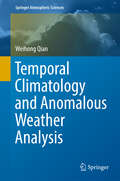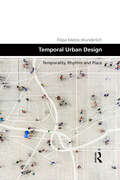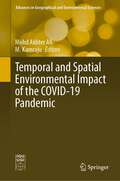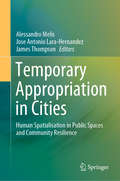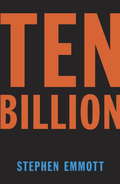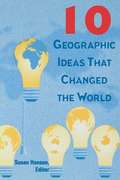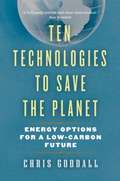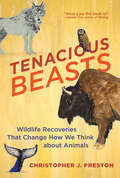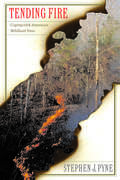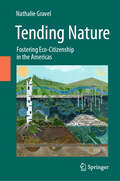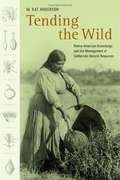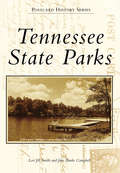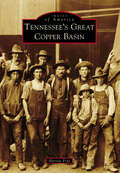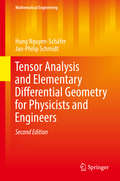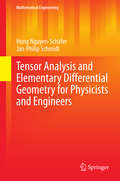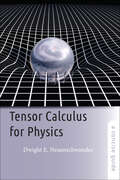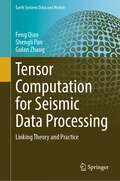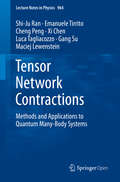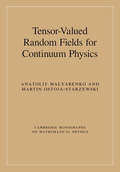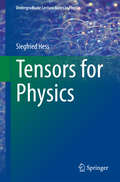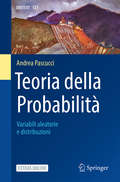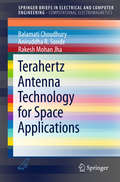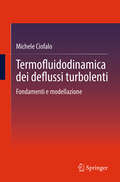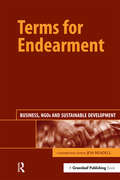- Table View
- List View
Temporal Climatology and Anomalous Weather Analysis
by Weihong QianBy breaking down atmospheric variables into temporal climatologies and anomalies, this book demonstrates that all weather extremes and climatic events are directly associated with the anomaly component of atmospheric motion. We can use the anomaly-based synoptic chart and dynamical parameters to objectively describe these extremes and events. The conception and differences of weather, climate and general circulation tend to confuse us, because there are no clear physical definitions available for them. Weather extremes such as heat waves, cold surges, freezing rains, heavy rains, severe drought, unusual storm tracks, and tornados are common on our planet’s surface. Climatic events such as Arctic warming and declining sea ice have become hot topics in recent years. An approach based on breaking down total variables into temporal climatologies and anomalies can be used to identify general circulation, analyze climatic anomalies and forecast weather extremes. Accordingly, this book will appeal to students, teachers and forecasters in the field of weather and climate alike.
Temporal Urban Design: Temporality, Rhythm and Place (Design and the Built Environment)
by Filipa Matos WunderlichTemporal Urban Design: Temporality, Rhythm and Place examines an alternative design approach, focusing on the temporal aesthetics of urban places and the importance of the sense of time and rhythm in the urban environment. The book departs from concerns on the acceleration of cities, its impact on the urban quality of life and the liveability of urban spaces, and questions on what influences the sense of time, and how it expresses itself in the urban environment. From here, it poses the questions: what time is this place and how do we design for it? It offers a new aesthetic perspective akin to music, brings forward the methodological framework of urban place-rhythmanalysis, and explores principles and modes of practice towards better temporal design quality in our cities. The book demonstrates that notions of time have long been intrinsic to planning and urban design research agendas and, whilst learning from philosophy, urban critical theory, and both the natural and social sciences debate on time, it argues for a shift in perspective towards the design of everyday urban time and place timescapes. Overall, the book explores the value of the everyday sense of time and rhythmicity in the urban environment, and discusses how urban designers can understand, analyse and ultimately play a role in the creation of temporally unique, both sensorial and affective, places in the city. The book will be of interest to urban planners, designers, landscape architects and architects, as well as urban geographers, and all those researching within these disciplines. It will also interest students of planning, urban design, architecture, urban studies, and of urban planning and design theory.
Temporal and Spatial Environmental Impact of the COVID-19 Pandemic (Advances in Geographical and Environmental Sciences)
by Mohd Akhter Ali M. KamrajuThis book identifies, evaluates and reports the impacts of the COVID-19 pandemic on the physical, biological and socioeconomic environment, using the science and technology of geoinformatics. It encourages the environmental considerations in the future city and policy planning and decision-making. For example, according to the World Health Organization, 80% of people living in cities are exposed to polluted air that exceeds healthy levels. City planners have applied the developing concepts of sustainability to modern debates over how cities and regions should be reviewed, regenerated and reformed since the introduction of the concept in developmental science. During the COVID-19 pandemic, a remarkable drop in air pollution has been observed in India and other countries, which has accelerated the shift to green and sustainable development. Geoinformatics can provide solutions and resources for local, sustainable activities in education, health, sustainable agriculture, resource management and related fields. This book serves researchers in a variety of areas, including hazards, land surveys, remote sensing, cartography, geophysics, geology, natural resources, environment and geography.
Temporary Appropriation in Cities: Human Spatialisation in Public Spaces and Community Resilience
by James Thompson Alessandro Melis Jose Antonio Lara-HernandezThis book conceptualises and illustrates temporary appropriation as an urban phenomenon, exploring its contributions to citizenship, urban social sustainability and urban health. It explains how some forms of appropriation can be subversive, existing in a grey area between legal and illegal activities in the city. The book explores the complex and the multi-scalar nature of temporary appropriation, and touches on its relationship to issues such as: sustainability and building re-use; culture; inclusivity, including socio-spatial inclusion; streetscape design; homelessness; and regulations controlling the use of public spaces. The book focuses on temporary appropriation as a necessity of adapting human needs in a city, highlighting the flexibility that is needed within urban planning and the further research that should be undertaken in this area. The book utilises case studies of Auckland, Algiers and Mexico City, and other cities with diverse cultural and historical backgrounds, to explore how planning, design and development can occur whilst maintaining community diversity and resilience. Since urban populations are certain to grow further, this is a key topic for understanding urban dynamics, and this book will be of interest to academics and practitioners alike.
Ten Billion
by Stephen EmmottA VINTAGE ORIGINALJust over two hundred years ago, there were one billion humans on Earth.There are now over seven billion of us.And, sometime this century, the world population will reach at least ten billion.Deforestation. Desertification. Species extinction. Global warming. Growing threats to food and water. The driving issues of our times are the result of one huge problem: Us. As the population continues to grow, our problems will increase. And this means that every way we look at it, a planet of ten billion people is likely to be a nightmare. Stephen Emmott, a scientist whose lab is at the forefront of research into complex natural systems, sounds the alarm. TEN BILLION is a snapshot of our planet, and our species, approaching a crisis, and a stark analysis of where this leaves us. TEN BILLION is not another climate book. TEN BILLION is a book about us.From the Trade Paperback edition.thing but a "green" book. And it's not another book about the climate. TEN BILLION is a book about us.From the Trade Paperback edition.
Ten Geographic Ideas That Changed the World
by Susan HansonIn these thought-provoking, witty essays, some of America's most distinguished geographers explore ten geographic ideas that have literally changed the world and the way we think and act.
Ten Technologies to Save the Planet
by Chris GoodallRespected, authoritative, award-winning author Chris Goodall tackles global warming reversal in this engaging and balanced book. Ten Technologies to Save the Planet - popular science writing at its most crucial - is arguably the most readable and comprehensive overview of large-scale solutions to climate change available. Goodall profiles ten technologies with the potential to slash global greenhouse emissions, explaining how they work and telling the stories of the inventors, scientists, and entrepreneurs who are driving them forward. Some of Goodall's selections, such as the electric car, are familiar. Others, like algae and charcoal, are more surprising. Illustrated with black-and-white photos and simple charts, Ten Technologies to Save the Planet combines cutting-edge analysis with straightforward explanations about pros and cons, and debunks myths along the way.
Tenacious Beasts: Wildlife Recoveries That Change How We Think about Animals
by Christopher J. PrestonAn inspiring look at wildlife species that are defying the odds and teaching important lessons about how to share a planet.The news about wildlife is dire—more than 900 species have been wiped off the planet since industrialization. Against this bleak backdrop, however, there are also glimmers of hope and crucial lessons to be learned from animals that have defied global trends toward extinction. Bear in Italy, bison in North America, whales in the Atlantic. These populations are back from the brink, some of them in numbers unimaginable in a century. How has this happened? What shifts in thinking did it demand? In crisp, transporting prose, Christopher Preston reveals the mysteries and challenges at the heart of these resurgences.Drawing on compelling personal stories from the researchers, Indigenous people, and activists who know the creatures best, Preston weaves together a gripping narrative of how some species are taking back vital, ecological roles. Each section of the book—farms, prairies, rivers, forests, oceans—offers a philosophical shift in how humans ought to think about animals, passionately advocating for the changes in attitude necessary for wildlife recovery.Tenacious Beasts is quintessential nature writing for the Anthropocene, touching on different facets of ecological restoration from Indigenous knowledge to rewilding practices. More important, perhaps, the book offers a road map—and a measure of hope—for a future in which humans and animals can once again coexist.
Tending Fire: Coping With America's Wildland Fires
by Stephen PyneThe wildfires that spread across Southern California in the fall of 2003 were devastating in their scale-twenty-two deaths, thousands of homes destroyed and many more threatened, hundreds of thousands of acres burned. What had gone wrong? And why, after years of discussion of fire policy, are some of America's most spectacular conflagrations arising now, and often not in a remote wilderness but close to large settlements?That is the opening to a brilliant discussion of the politics of fire by one of the country's most knowledgeable writers on the subject, Stephen J. Pyne. Once a fire fighter himself (for fifteen seasons, on the North Rim of the Grand Canyon) and now a professor at Arizona State University, Pyne gives us for the first time a book-length discussion of fire policy, of how we have come to this pass, and where we might go from here.Tending Fire provides a remarkably broad, sometimes startling context for understanding fire. Pyne traces the "ancient alliance" between fire and humanity, delves into the role of European expansion and the creation of fire-prone public lands, and then explores the effects wrought by changing policies of "letting burn" and suppression. How, the author asks, can we better protect ourselves against the fires we don't want, and better promote those we do?Pyne calls for important reforms in wildfire management and makes a convincing plea for a more imaginative conception of fire, though always grounded in a vivid sense of fire's reality. "Amid the shouting and roar, a central fact remains," he writes. "Fire isn't listening. It doesn't feel our pain. It doesn't care-really, really doesn't care. It understands a language of wind, drought, woods, grass, brush, and terrain, and it will ignore anything stated otherwise."Rich in insight, wide-ranging in its subject, and clear-eyed in its proposals, Tending Fire is for anyone fascinated by fire, fire policy, or human culture.
Tending Nature: Fostering Eco-Citizenship in the Americas
by Nathalie GravelThis book aims to enhance understanding of the foundational principles and ethical considerations of citizen engagement in environmental conservation through an examination of successful cases of shared environmental governance in the Americas. It seeks to inform policymaking on strategies for fostering behavioral change and advancing towards co-management of national public resources and the commons. These cases are analyzed through a geographical lens to provide a framework for reimagining eco-citizenship grounded in bioregionalism. This perspective diverges from the notion of eco-citizenship as a universal culture, advocating instead for its integration within the collective habitats of citizen groups. Readers will gain insights into fostering reconciliation between nature and humanity by empowering diverse stakeholders to lead Blue/Green/Bee conservation initiatives. Emphasizing community learning, environmental awareness, and citizen participation, the book enriches decision-making processes and promotes environmental justice for all living organisms. The selected case studies from Brazil, Canada, Costa Rica, Mexico, and the United States highlight pioneering innovations in Blue/Green/Bee policy planning across urban, periurban, and rural settings. These initiatives propose empathetic and respectful approaches to nurturing our natural surroundings, including methods for co-management, networked urban gardening, wild native bee conservation, water source protection, community-based water management, river revitalization, and metropolitan green space stewardship. This book will be invaluable to students, urban and rural planners, researchers, academics, networking professionals, policymakers, international development practitioners, environmental organization personnel, and enthusiasts of the natural world alike.
Tending the Wild: Native American Knowledge and the Management of California's Natural Resources
by M. Kat AndersonAnderson's revolutionary thesis is that, far from being passive hunter and gatherers, Native Californians (and Native Americans generally) actively managed their natural environments in ways that today land managers could learn from.
Tennessee State Parks (Postcard History Series)
by Jane Banks Campbell Lori Jill SmithThe story of Tennessee’s state parks began more than 80 years ago when New Deal agencies worked to rebuild portions of Tennessee’s eroded landscape. Along with these conservation measures, the state’s early parks were created through the development of recreational areas. The Tennessee Valley Authority built dams that contributed to recreational attractions, and the Division of State Parks was started in 1937. All of these efforts in addition to Tennessee’s natural beauty have resulted in 56 state parks. Through their postcard collections, the authors invite readers to discover each park’s special place in Tennessee’s history and landscape.
Tennessee’s Great Copper Basin (Images of America)
by Harriet FryeIn 1843, the discovery of copper in Tennessee’s far southeastern corner sparked a transformation in the isolated area known to geologists as the Ducktown Basin. By 1854, the first shafts had been sunk, and 28 mining companies had been incorporated for the purpose of exploring the possible wealth of the Ducktown district. For generations to come, the families of mine captains from Cornwall, executives and engineers from the industrial North, emigrants from Europe and the Middle East, miners drawn by the promise of jobs, and farmers who had bought land for pennies an acre in the 1830s would sit side by side in the same small churches and send their children to the same small schools. In the process, they would create a kind of culture that few small Southern communities had ever seen. This book, illustrated with photographs gathered from the scrapbooks and attics of their descendants, tells their story.
Tensions in Diversity: Spaces for Collective Life in Los Angeles
by Felicity Hwee-Hwa ChanUrban landscapes are complex spaces of sociocultural diversity, characterized by narratives of both conviviality and conflict. As people with multiple ethnicities and nationalities find their common destinies in thriving globalizing cities, social cohesiveness becomes more precarious as different beliefs, practices, ambitions, values, and affiliations intersect in close proximity, producing social tensions. Tensions in Diversity presents a multi-method comparative study that draws on the experiences of 140 residents of native and immigrant origin, community organizers, and municipal officers in three culturally diverse neighbourhoods of varying income levels in Los Angeles County. Using cognitive mapping analysis combined with data from interviews, surveys, and participant observation, this book explores how exactly coexistence is socio-spatially experienced and negotiated in daily life. Tensions in Diversity identifies the planning and design considerations that enable intercultural learning in the public places within diverse cities. In doing so, this book foregrounds urban space as an active force in shaping coexistence and convivial public environments.
Tensor Analysis and Elementary Differential Geometry for Physicists and Engineers (Mathematical Engineering #21)
by Hung Nguyen-Schäfer Jan-Philip SchmidtThis book presents tensors and differential geometry in a comprehensive and approachable manner, providing a bridge from the place where physics and engineering mathematics end, and the place where tensor analysis begins. Among the topics examined are tensor analysis, elementary differential geometry of moving surfaces, and k-differential forms. The book includes numerous examples with solutions and concrete calculations, which guide readers through these complex topics step by step. Mindful of the practical needs of engineers and physicists, book favors simplicity over a more rigorous, formal approach. The book shows readers how to work with tensors and differential geometry and how to apply them to modeling the physical and engineering world.The authors provide chapter-length treatment of topics at the intersection of advanced mathematics, and physics and engineering: • General Basis and Bra-Ket Notation• Tensor Analysis• Elementary Differential Geometry• Differential Forms• Applications of Tensors and Differential Geometry• Tensors and Bra-Ket Notation in Quantum MechanicsThe text reviews methods and applications in computational fluid dynamics; continuum mechanics; electrodynamics in special relativity; cosmology in the Minkowski four-dimensional space time; and relativistic and non-relativistic quantum mechanics.Tensor Analysis and Elementary Differential Geometry for Physicists and Engineers benefits research scientists and practicing engineers in a variety of fields, who use tensor analysis and differential geometry in the context of applied physics, and electrical and mechanical engineering. It will also interest graduate students in applied physics and engineering.
Tensor Analysis and Elementary Differential Geometry for Physicists and Engineers (Mathematical Engineering)
by Hung Nguyen-Schäfer Jan-Philip SchmidtTensors and methods of differential geometry are very useful mathematical tools in many fields of modern physics and computational engineering including relativity physics, electrodynamics, computational fluid dynamics (CFD), continuum mechanics, aero and vibroacoustics and cybernetics.This book comprehensively presents topics, such as bra-ket notation, tensor analysis and elementary differential geometry of a moving surface. Moreover, authors intentionally abstain from giving mathematically rigorous definitions and derivations that are however dealt with as precisely as possible. The reader is provided with hands-on calculations and worked-out examples at which he will learn how to handle the bra-ket notation, tensors and differential geometry and to use them in the physical and engineering world. The target audience primarily comprises graduate students in physics and engineering, research scientists and practicing engineers.
Tensor Calculus for Physics: A Concise Guide
by Dwight E. NeuenschwanderUsing a clear, step-by-step approach, this book explains one of the more difficult—yet crucial—topics in physics.Understanding tensors is essential for any physics student dealing with phenomena where causes and effects have different directions. A horizontal electric field producing vertical polarization in dielectrics; an unbalanced car wheel wobbling in the vertical plane while spinning about a horizontal axis; an electrostatic field on Earth observed to be a magnetic field by orbiting astronauts—these are some situations where physicists employ tensors. But the true beauty of tensors lies in this fact: When coordinates are transformed from one system to another, tensors change according to the same rules as the coordinates. Tensors, therefore, allow for the convenience of coordinates while also transcending them. This makes tensors the gold standard for expressing physical relationships in physics and geometry. Undergraduate physics majors are typically introduced to tensors in special-case applications. For example, in a classical mechanics course, they meet the "inertia tensor," and in electricity and magnetism, they encounter the "polarization tensor." However, this piecemeal approach can set students up for misconceptions when they have to learn about tensors in more advanced physics and mathematics studies (e.g., while enrolled in a graduate-level general relativity course or when studying non-Euclidean geometries in a higher mathematics class). Dwight E. Neuenschwander's Tensor Calculus for Physics is a bottom-up approach that emphasizes motivations before providing definitions. Using a clear, step-by-step approach, the book strives to embed the logic of tensors in contexts that demonstrate why that logic is worth pursuing. It is an ideal companion for courses such as mathematical methods of physics, classical mechanics, electricity and magnetism, and relativity.
Tensor Computation for Seismic Data Processing: Linking Theory and Practice (Earth Systems Data and Models #6)
by Feng Qian Shengli Pan Gulan ZhangThis book aims to provide a comprehensive understanding of tensor computation and its applications in seismic data analysis, exclusively catering to seasoned researchers, graduate students, and industrial engineers alike. Tensor emerges as a natural representation of multi-dimensional modern seismic data, and tensor computation can help prevent possible harm to the multi-dimensional geological structure of the subsurface that occurred in classical seismic data analysis. It delivers a wealth of theoretical, computational, technical, and experimental details, presenting an engineer's perspective on tensor computation and an extensive investigation of tensor-based seismic data analysis techniques. Embark on a transformative exploration of seismic data processing—unlock the potential of tensor computation and reshape your approach to high-dimensional geological structures. The discussion begins with foundational chapters, providing a solid background in both seismic data processing and tensor computation. The heart of the book lies in its seven chapters on tensor-based seismic data analysis methods. From structured low-tubal-rank tensor completion to cutting-edge techniques like tensor deep learning and tensor convolutional neural networks, each method is meticulously detailed. The superiority of tensor-based data analysis methods over traditional matrix-based data analysis approaches is substantiated through synthetic and real field examples, showcasing their prowess in handling high-dimensional modern seismic data. Notable chapters delve into seismic noise suppression, seismic data interpolation, and seismic data super-resolution using advanced tensor models. The final chapter provides a cohesive summary of the conclusion and future research directions, ensuring readers facilitate a thorough understanding of tensor computation applications in seismic data processing. The appendix includes a hatful of information on existing tensor computation software, enhancing the book's practical utility.
Tensor Network Contractions: Methods and Applications to Quantum Many-Body Systems (Lecture Notes in Physics #964)
by Xi Chen Gang Su Maciej Lewenstein Shi-Ju Ran Emanuele Tirrito Cheng Peng Luca TagliacozzoTensor network is a fundamental mathematical tool with a huge range of applications in physics, such as condensed matter physics, statistic physics, high energy physics, and quantum information sciences. This open access book aims to explain the tensor network contraction approaches in a systematic way, from the basic definitions to the important applications. This book is also useful to those who apply tensor networks in areas beyond physics, such as machine learning and the big-data analysis. Tensor network originates from the numerical renormalization group approach proposed by K. G. Wilson in 1975. Through a rapid development in the last two decades, tensor network has become a powerful numerical tool that can efficiently simulate a wide range of scientific problems, with particular success in quantum many-body physics. Varieties of tensor network algorithms have been proposed for different problems. However, the connections among different algorithms are not well discussed or reviewed. To fill this gap, this book explains the fundamental concepts and basic ideas that connect and/or unify different strategies of the tensor network contraction algorithms. In addition, some of the recent progresses in dealing with tensor decomposition techniques and quantum simulations are also represented in this book to help the readers to better understand tensor network. This open access book is intended for graduated students, but can also be used as a professional book for researchers in the related fields. To understand most of the contents in the book, only basic knowledge of quantum mechanics and linear algebra is required. In order to fully understand some advanced parts, the reader will need to be familiar with notion of condensed matter physics and quantum information, that however are not necessary to understand the main parts of the book. This book is a good source for non-specialists on quantum physics to understand tensor network algorithms and the related mathematics.
Tensor-Valued Random Fields for Continuum Physics (Cambridge Monographs on Mathematical Physics)
by Anatoliy Malyarenko Martin Ostoja-StarzewskiMany areas of continuum physics pose a challenge to physicists. What are the most general, admissible statistically homogeneous and isotropic tensor-valued random fields (TRFs)? Previously, only the TRFs of rank 0 were completely described. This book assembles a complete description of such fields in terms of one- and two-point correlation functions for tensors of ranks 1 through 4. Working from the standpoint of invariance of physical laws with respect to the choice of a coordinate system, spatial domain representations, as well as their wavenumber domain counterparts are rigorously given in full detail. The book also discusses, an introduction to a range of continuum theories requiring TRFs, an introduction to mathematical theories necessary for the description of homogeneous and isotropic TRFs, and a range of applications including a strategy for simulation of TRFs, ergodic TRFs, scaling laws of stochastic constitutive responses, and applications to stochastic partial differential equations. It is invaluable for mathematicians looking to solve problems of continuum physics, and for physicists aiming to enrich their knowledge of the relevant mathematical tools.
Tensors for Physics
by Siegfried HessThis book presents the science of tensors in a didactic way. The various types and ranks of tensors and the physical basis is presented. Cartesian Tensors are needed for the description of directional phenomena in many branches of physics and for the characterization the anisotropy of material properties. The first sections of the book provide an introduction to the vector and tensor algebra and analysis, with applications to physics, at undergraduate level. Second rank tensors, in particular their symmetries, are discussed in detail. Differentiation and integration of fields, including generalizations of the Stokes law and the Gauss theorem, are treated. The physics relevant for the applications in mechanics, quantum mechanics, electrodynamics and hydrodynamics is presented. The second part of the book is devoted to tensors of any rank, at graduate level. Special topics are irreducible, i. e. symmetric traceless tensors, isotropic tensors, multipole potential tensors, spin tensors, integration and spin-trace formulas, coupling of irreducible tensors, rotation of tensors. Constitutive laws for optical, elastic and viscous properties of anisotropic media are dealt with. The anisotropic media include crystals, liquid crystals and isotropic fluids, rendered anisotropic by external orienting fields. The dynamics of tensors deals with phenomena of current research. In the last section, the 3D Maxwell equations are reformulated in their 4D version, in accord with special relativity.
Teoria della Probabilità: Variabili aleatorie e distribuzioni (UNITEXT #123)
by Andrea PascucciIl libro fornisce un'introduzione concisa ma rigorosa alla Teoria della Probabilità. Fra i possibili approcci alla materia si è scelto quello più moderno, basato sulla teoria della misura: pur richiedendo un grado di astrazione e sofisticazione matematica maggiore, esso è indispensabile a fornire le basi per lo studio di argomenti più avanzati come i processi stocastici, il calcolo differenziale stocastico e l'inferenza statistica. Nato dall'esperienza di insegnamento del corso di Probabilità e Statistica Matematica presso la Laurea Triennale in Matematica dell'Università di Bologna, il testo raccoglie materiale per un insegnamento semestrale in corsi di studio scientifici (Matematica, Fisica, Ingegneria, Statistica...), assumendo come prerequisito il calcolo differenziale e integrale di funzioni di più variabili. I quattro capitoli del libro trattano i seguenti argomenti: misure e spazi di probabilità; variabili aleatorie; successioni di variabili aleatorie e teoremi limite; attesa e distribuzione condizionata. Il testo include una raccolta di esercizi risolti.
Terahertz Antenna Technology for Space Applications (SpringerBriefs in Electrical and Computer Engineering)
by Rakesh Mohan Jha Balamati Choudhury Aniruddha R. SondeThis book explores the terahertz antenna technology towards implementation of compact, consistent and cheap terahertz sources, as well as the high sensitivity terahertz detectors. The terahertz EM band provides a transition between the electronic and the photonic regions thus adopting important characteristics from these regimes. These characteristics, along with the progress in semiconductor technology, have enabled researchers to exploit hitherto unexplored domains including satellite communication, bio-medical imaging, and security systems. The advances in new materials and nanostructures such as graphene will be helpful in miniaturization of antenna technology while simultaneously maintaining the desired output levels. Terahertz antenna characterization of bandwidth, impedance, polarization, etc. has not yet been methodically structured and it continues to be a major research challenge. This book addresses these issues besides including the advances of terahertz technology in space applications worldwide, along with possibilities of using this technology in deep space networks.
Termofluidodinamica dei deflussi turbolenti: Fondamenti e modellazione
by Michele CiofaloIl testo fornisce i fondamenti teorici della turbolenza e una panoramica completa dei modelli di turbolenza, dai più semplici ai più avanzati, tra cui la simulazione diretta e la simulazione Large Eddy. Si concentra principalmente sui problemi di modellazione e calcolo e fornisce informazioni sulla teoria dei sistemi dinamici e sulle loro biforcazioni. Esamina anche aspetti della turbolenza che non sono trattati nella maggior parte dei libri esistenti su questo argomento, come la turbolenza in convezione libera e mista, la turbolenza transitoria e la transizione alla turbolenza. Il libro adotta la notazione tensoriale, che è la più appropriata per trattare quantità intrinsecamente tensoriali come le sollecitazioni e i tassi di deformazione, e per coloro che non hanno familiarità con essa viene fornita un'appendice sull'algebra tensoriale e sulla notazione tensoriale.
Terms for Endearment: Business, NGOs and Sustainable Development
by Jem BendellBusiness and NGOs are seen by many to be locked in a perpetual war of values and ideologies. What this book demonstrates is that the war has moved on. Many companies are now engaging with their stakeholders – even those with which they have traditionally had antagonistic relationships – as part of their strategies for improved social and environmental performance. With contributions from an outstanding and diverse group of experts from business, consultancy, research institutes, NGOs and academia, Terms for Endearment investigates the how and why of these new collaborations and provides concrete examples of business working with stakeholder pressure for sustainable development. The book forcibly argues the notion of organizations of civil society setting the standards for business behaviour in the 21st century. For those companies that choose not to pursue high standards of social and environmental performance, confrontation with NGOs must be expected, with negative consequences for sales, costs and social capital, i.e. the bottom line. Terms for Endearment therefore presents business with both a threat and opportunity as we move closer to establishing a social basis for global economic activity.
